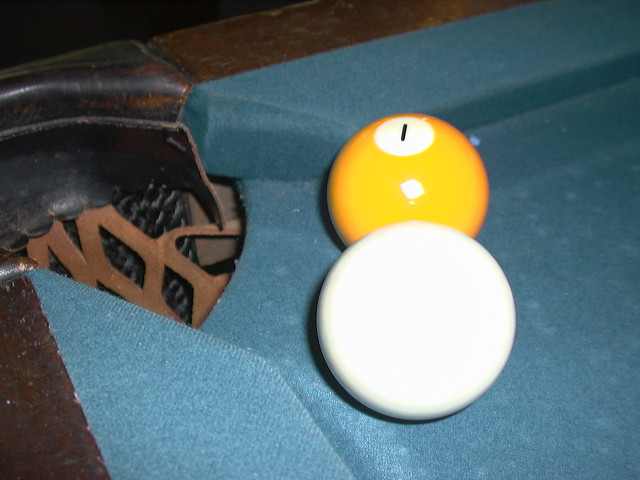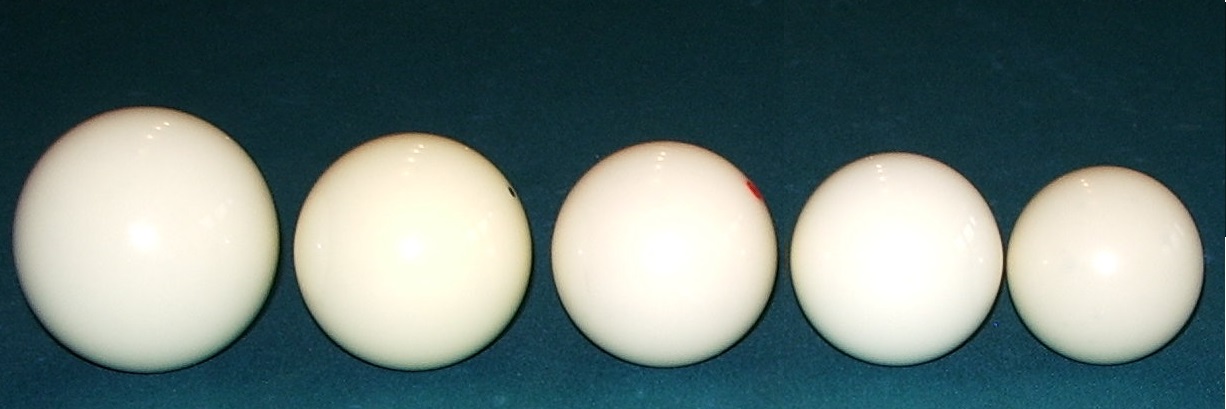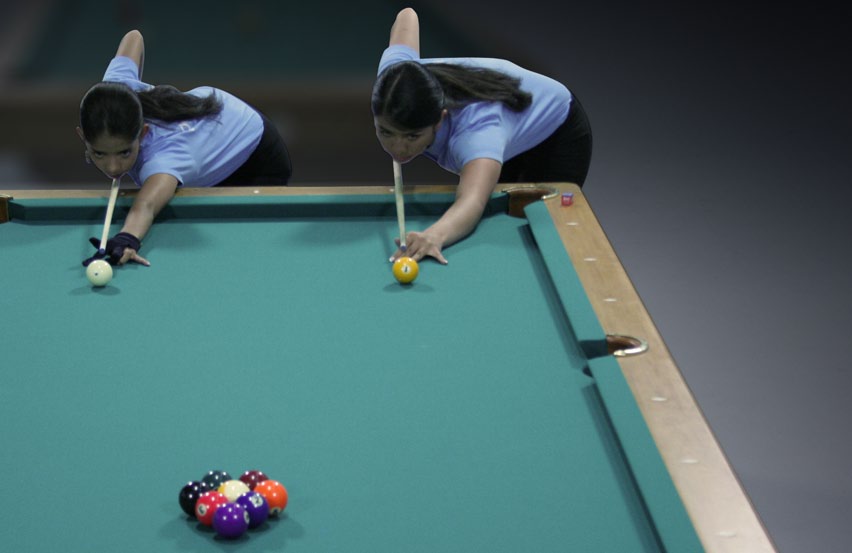|
Billiards
Cue sports are a wide variety of games of skill played with a cue, which is used to strike billiard balls and thereby cause them to move around a cloth-covered table bounded by elastic bumpers known as . There are three major subdivisions of games within cue sports: *Carom billiards, played on tables without , typically 10 feet in length, including straight rail, balkline, one-cushion carom, three-cushion billiards, artistic billiards, and four-ball *Pool, played on six-pocket tables of 7-, 8-, 9-, or 10-foot length, including among others eight-ball (the world's most widely played cue sport), nine-ball (the dominant professional game), ten-ball, straight pool (the formerly dominant pro game), one-pocket, and bank pool *Snooker, English billiards, and Russian pyramid, played on a large, six-pocket table (dimensions just under 12 ft by 6 ft), all of which are classified separately from pool based on distinct development histories, player culture, rules, and terminol ... [...More Info...] [...Related Items...] OR: [Wikipedia] [Google] [Baidu] |
Ground Billiards
Ground billiards is a modern term for a family of medieval European lawn games, the original names of which are mostly unknown, played with a long-handled mallet (the '), wooden balls, a hoop (the ''pass''), and an upright skittle or pin (the ''king''). The game, which cue-sports historians have called "the original game of billiards", developed into a variety of modern outdoor and indoor games and sports such as croquet, pool, snooker, and carom billiards. Its relationship to games played on larger fields, such as hockey, golf, and bat-and-ball games, is more speculative. As a broader classification, the term is sometimes applied to games dating back to classical antiquity that are attested via difficult-to-interpret ancient artworks and rare surviving gaming artifacts. History Dating back to at least the 15th century as a tabletop game, and in recognizable form to as early as the 14th, this proto-billiards game appears to have been ancestral to croquet (19th century), trucco ... [...More Info...] [...Related Items...] OR: [Wikipedia] [Google] [Baidu] |
Carom Billiards
Carom billiards, sometimes called carambole billiards, is the overarching title of a family of cue sports generally played on cloth-covered, billiard tables. In its simplest form, the object of the game is to score or "counts" by ' one's own off both the opponent's cue ball and the on a single shot. The invention as well as the exact date of origin of carom billiards is somewhat obscure but is thought to be traceable to 18th-century France. There is a large array of carom billiards disciplines. Some of the more prevalent today and historically are (chronologically by apparent date of development): straight rail, one-cushion, balkline, three-cushion and artistic billiards. Carom billiards is popular in Europe, particularly France, where it originated. It is also popular in Asian countries, including Japan, the Philippines, South Korea, and Vietnam, but is now considered obscure in North America, having been supplanted by pool in popularity. The Union Mondiale de Bill ... [...More Info...] [...Related Items...] OR: [Wikipedia] [Google] [Baidu] |
Billiard Table
A billiard table or billiards table is a bounded table on which cue sports are played. In the modern era, all billiards tables (whether for carom billiards, pool, pyramid or snooker) provide a flat surface usually made of quarried slate, that is covered with cloth (usually of a tightly woven worsted wool called baize), and surrounded by vulcanized rubber cushions, with the whole thing elevated above the floor. More specific terms are used for specific sports, such as snooker table and pool table, and different-sized billiard balls are used on these table types. An obsolete term is billiard board, used in the 16th and 17th centuries. Parts and equipment Cushions Cushions (also sometimes called "rail cushions", "cushion rubber", or rarely "bumpers") are located on the inner sides of a table's wooden . There are several different materials and design philosophies associated with cushion rubber. These cushions are made from an elastic material such as vulcanized rubber (gum or s ... [...More Info...] [...Related Items...] OR: [Wikipedia] [Google] [Baidu] |
Billiards Table
A billiard table or billiards table is a bounded table on which cue sports are played. In the modern era, all billiards tables (whether for carom billiards, pool, pyramid or snooker) provide a flat surface usually made of quarried slate, that is covered with cloth (usually of a tightly woven worsted wool called baize), and surrounded by vulcanized rubber cushions, with the whole thing elevated above the floor. More specific terms are used for specific sports, such as snooker table and pool table, and different-sized billiard balls are used on these table types. An obsolete term is billiard board, used in the 16th and 17th centuries. Parts and equipment Cushions Cushions (also sometimes called "rail cushions", "cushion rubber", or rarely "bumpers") are located on the inner sides of a table's wooden . There are several different materials and design philosophies associated with cushion rubber. These cushions are made from an elastic material such as vulcanized rubber (gum or sy ... [...More Info...] [...Related Items...] OR: [Wikipedia] [Google] [Baidu] |
Pool (cue Sports)
Pool is a classification of cue sports played on a table with six pockets along the , into which balls are deposited. "Pool billiards" is sometimes hyphenated and/or spelled with a singular "billiard". The WPA itself uses "pool-billiard" in its logo but "pool-billiards" in its legal notices. The organization compounds the words to result in an acronym of "WPA", "WPBA" having already been taken by the Women's Professional Billiards Association. Normal English grammar would not hyphenate here, and the term is actually a Germanism. A general rules booklet on pool games in general, including eight-ball, nine-ball and several others. Each specific pool game has its own name; some of the better-known include eight-ball, blackball, nine-ball, ten-ball, seven-ball, straight pool, one-pocket, and bank pool. The generic term pocket billiards is sometimes also used, and favored by some pool-industry bodies, but is technically a broader classification, including games such as snooker, ... [...More Info...] [...Related Items...] OR: [Wikipedia] [Google] [Baidu] |
English Billiards
English billiards, called simply billiards in the United Kingdom and in many former British colonies, is a cue sport that combines the aspects of carom billiards and pool. Two (one white and one yellow) and a red are used. Each player or team uses a different cue ball. It is played on a billiards table with the same dimensions as one used for snooker and points are scored for and pocketing the balls. History English billiards originated in England, and was originally called the ''winning and losing carambole game'', folding in the names of three predecessor games, ''the winning game'', ''the losing game'', and an early form of carom billiards that combined to form it. The winning game was played with two white balls, and was a 12- contest. To start, the player who could strike a ball at one end of the table and get the ball to come to rest nearest the opposite cushion without lying against it earned the right to shoot for points first. This is the origin of the modern cust ... [...More Info...] [...Related Items...] OR: [Wikipedia] [Google] [Baidu] |
Three-cushion Billiards
Three-cushion billiards, also called three-cushion carom, is a form of carom billiards. The object of the game is to the off both while contacting the at least three times before contacting the second object ball. A point is scored for each successful carom. In most shots the cue ball hits the object balls one time each, although hitting them any number of times is allowed as long as both are hit. The cue ball may contact the cushions before or after hitting the first object ball. It does not have to contact three different cushions as long as it has been in contact with any cushion at least three times in total. History Three-cushion dates to the 1870s, and while the origin of the game is not entirely known, it evolved from one-cushion billiards, which in turn developed from straight rail billiards for the same reason that balkline also arose from straight rail. Such new developments made the game more challenging, less repetitive, and more interesting for spectators as we ... [...More Info...] [...Related Items...] OR: [Wikipedia] [Google] [Baidu] |
Billiard Ball
A billiard ball is a small, hard ball used in cue sports, such as carom billiards, pool, and snooker. The number, type, diameter, color, and pattern of the balls differ depending upon the specific game being played. Various particular ball properties such as hardness, friction coefficient, and resilience are important to accuracy. History Early balls were made of various materials, including wood and clay (the latter remaining in use well into the 20th century). Although affordable ox-bone balls were in common use in Europe, elephant ivory was favored since at least 1627 until the early 20th century; the earliest known written reference to ivory billiard balls is in the 1588 inventory of the Duke of Norfolk. Dyed and numbered balls appeared around the early 1770s. By the mid-19th century, elephants were being slaughtered for their ivory at an alarming rate, just to keep up with the demand for high-end billiard balls – no more than eight balls could be made from a single e ... [...More Info...] [...Related Items...] OR: [Wikipedia] [Google] [Baidu] |
Billiard Ball
A billiard ball is a small, hard ball used in cue sports, such as carom billiards, pool, and snooker. The number, type, diameter, color, and pattern of the balls differ depending upon the specific game being played. Various particular ball properties such as hardness, friction coefficient, and resilience are important to accuracy. History Early balls were made of various materials, including wood and clay (the latter remaining in use well into the 20th century). Although affordable ox-bone balls were in common use in Europe, elephant ivory was favored since at least 1627 until the early 20th century; the earliest known written reference to ivory billiard balls is in the 1588 inventory of the Duke of Norfolk. Dyed and numbered balls appeared around the early 1770s. By the mid-19th century, elephants were being slaughtered for their ivory at an alarming rate, just to keep up with the demand for high-end billiard balls – no more than eight balls could be made from a single e ... [...More Info...] [...Related Items...] OR: [Wikipedia] [Google] [Baidu] |
Straight Pool
Straight pool, which is also called 14.1 continuous and 14.1 rack, is a cue sport in which two competing players attempt to as many billiard balls as possible without playing a . The game was the primary version of pool played in professional competition until it was superseded by faster-playing games like nine-ball and eight-ball in the 1980s. In straight pool, the player may and attempt to pocket any object ball on the table regardless of its number or color until only one object ball and the remain, at which point the other fourteen balls are re-racked. At this point, play resumes with the objective of pocketing the remaining ball in a manner that causes the cue ball to carom into the rack, spreading out the balls and allowing the player to continue the run. The goal is to reach a set number of points that is determined by agreement before the game begins; traditionally 100 points is needed for a win, though professional matches may be higher. One point is scored by pocke ... [...More Info...] [...Related Items...] OR: [Wikipedia] [Google] [Baidu] |
Nine-ball
Nine-ball (sometimes written 9-ball) is a discipline of the cue sport pool. The game's origins are traceable to the 1920s in the United States. It is played on a rectangular billiard table with at each of the four corners and in the middle of each long side. Using a cue stick, players must strike the white cue ball to nine colored billiard balls, hitting them in ascending numerical order. An individual game (or ) is won by the player pocketing the . Matches are usually played as a to a set number of racks, with the player who reaches the set number winning the match. The game is currently governed by the World Pool-Billiard Association (WPA), with multiple regional tours. The most prestigious nine-ball tournaments are the WPA World Nine-ball Championship and the U.S. Open Nine-ball Championships. Notable 9-Ball players in the game include Luther Lassiter, Buddy Hall, Earl Strickland and Shane Van Boening. The game is often associated with hustling and gambling, with tourn ... [...More Info...] [...Related Items...] OR: [Wikipedia] [Google] [Baidu] |
World Confederation Of Billiards Sports
The World Confederation of Billiards Sports (WCBS) is the international umbrella organization encompassing the major cue sports (billiards-type games), including carom billiards, pool games of several varieties, and snooker.WCBS official website accessed May 12, 2007. It is sometimes called the World Confederation of ''Billiards'' Sports; the logo on the site uses the singular form of the name, while copies of the organisation's founding documents on the site use the plural version The confederation was formed in , , on January 25, 1992. [...More Info...] [...Related Items...] OR: [Wikipedia] [Google] [Baidu] |








_LCCN2014682795_(cropped).jpg)
